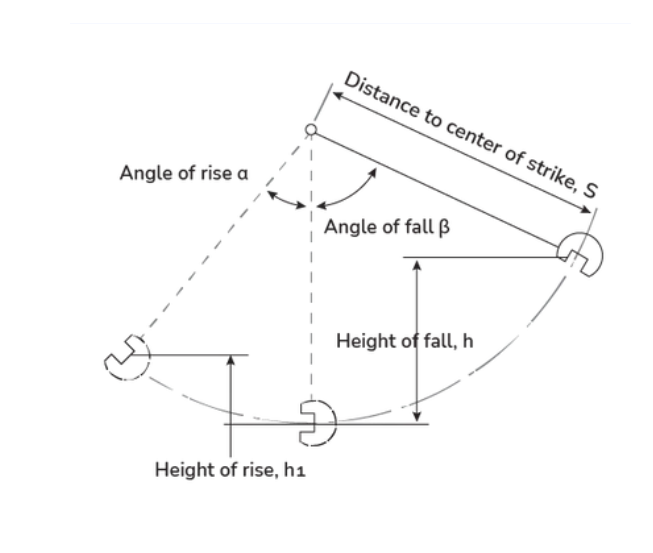1. What is Impact Test Calculator?
Definition: This calculator computes the fracture energy absorbed by a material specimen during an Izod impact test, along with the initial and final heights of the pendulum and the impact velocity of the striker.
Purpose: It is used in material science and engineering to evaluate the toughness and impact resistance of materials, helping to determine their suitability for various applications.
2. How Does the Calculator Work?
The calculator uses the following formulas:
Formulas:
- Initial Height: \[
h = S(1 - \cos \beta)
\]
- Final Height: \[
h_1 = S(1 - \cos \alpha)
\]
- Energy Absorbed: \[
E = mgS(\cos \alpha - \cos \beta)
\]
- Impact Velocity: \[
V = \sqrt{2gh}
\]
Where:
- \( h \): Initial height (mm, cm, m, in, ft)
- \( h_1 \): Final height (mm, cm, m, in, ft)
- \( E \): Energy absorbed (J, kJ, ft-lb)
- \( V \): Impact velocity (m/s, km/h, mph)
- \( \alpha \): Angle of fall (degrees)
- \( \beta \): Angle of rise (degrees)
- \( m \): Mass of anvil (kg, g, lb)
- \( S \): Pendulum length (mm, cm, m, in, ft)
- \( g \): Acceleration due to gravity (m/s², varies by planet)
Unit Conversions:
- Mass (\( m \)):
- 1 kg = 1 kg
- 1 g = 0.001 kg
- 1 lb = 0.453592 kg
- Length/Height (\( S \), \( h \), \( h_1 \)):
- 1 mm = 0.001 m
- 1 cm = 0.01 m
- 1 m = 1 m
- 1 in = 0.0254 m
- 1 ft = 0.3048 m
- Energy (\( E \)):
- 1 J = 1 J
- 1 kJ = 1000 J
- 1 ft-lb = 1.35582 J
- Velocity (\( V \)):
- 1 m/s = 1 m/s
- 1 km/h = 0.277778 m/s
- 1 mph = 0.44704 m/s
Steps:
- Enter the angle of fall (\( \alpha \)) and angle of rise (\( \beta \)) in degrees.
- Enter the mass of the anvil (\( m \)) and select its unit.
- Enter the pendulum length (\( S \)) and select its unit.
- Select the planet to determine the gravitational acceleration (\( g \)).
- Convert all inputs to SI units (kg for mass, m for length, radians for angles).
- Calculate the initial height (\( h \)), final height (\( h_1 \)), energy absorbed (\( E \)), and impact velocity (\( V \)).
- Convert the results to the selected units.
- Display the results, using scientific notation for values less than 0.001, otherwise with 4 decimal places.
3. Importance of Impact Test Calculation
Calculating the impact energy is crucial for:
- Material Testing: Evaluating the toughness and impact resistance of materials under dynamic loading conditions.
- Engineering Design: Selecting materials for applications where impact resistance is critical, such as in automotive, aerospace, and construction industries.
- Quality Control: Ensuring that materials meet specified standards for impact strength in manufacturing processes.
4. Using the Calculator
Example:
Determine the fracture energy for a material specimen undergoing the Izod impact test with the following data: angle of fall \( \alpha = 60^\circ \), angle of rise \( \beta = 30^\circ \), mass of anvil \( m = 440 \, \text{g} \), pendulum length \( S = 1 \, \text{m} \), on Earth (\( g = 9.80665 \, \text{m/s}^2 \)).
- Enter the angle of fall, \( \alpha = 60^\circ \).
- Fill in the angle of rise, \( \beta = 30^\circ \).
- Enter the mass of anvil, \( m = 440 \, \text{g} \).
- Insert the pendulum length, \( S = 1 \, \text{m} \).
- Select the planet as Earth (\( g = 9.80665 \, \text{m/s}^2 \)).
- The calculator returns the initial and final heights, \( h \) and \( h_1 \), as:
- \( h = S(1 - \cos \beta) = 1(1 - \cos 30^\circ) = 0.13397 \, \text{m} \)
- \( h_1 = S(1 - \cos \alpha) = 1(1 - \cos 60^\circ) = 0.5 \, \text{m} \)
- The calculator returns the energy absorbed, \( E \), as:
- \( E = mgS(\cos \alpha - \cos \beta) \)
- \( = 0.44 \times 9.80665 \times 1 \times (\cos 60^\circ - \cos 30^\circ) \)
- \( = 1.5794 \, \text{J} \)
- The impact velocity of the striker is:
- \( V = \sqrt{2gh} \)
- \( = \sqrt{2 \times 9.80665 \times 0.5} \)
- \( = 3.1316 \, \text{m/s} \)
5. Frequently Asked Questions (FAQ)
Q: What is the Impact Test Calculator?
A: The Impact Test Calculator computes the fracture energy absorbed by a material specimen during an Izod impact test, along with the initial and final heights of the pendulum and the impact velocity of the striker.
Q: Why does the gravitational acceleration vary for different planets?
A: Gravitational acceleration depends on the mass and radius of the planet. Different planets have different gravitational forces, affecting the energy and velocity calculations in the impact test.
Q: How is the Impact Test Calculator used in real life?
A: It is used in material testing to evaluate the toughness of materials, in engineering design to select materials for impact-resistant applications, and in quality control to ensure materials meet impact strength standards.
 Home
Home
 Back
Back
